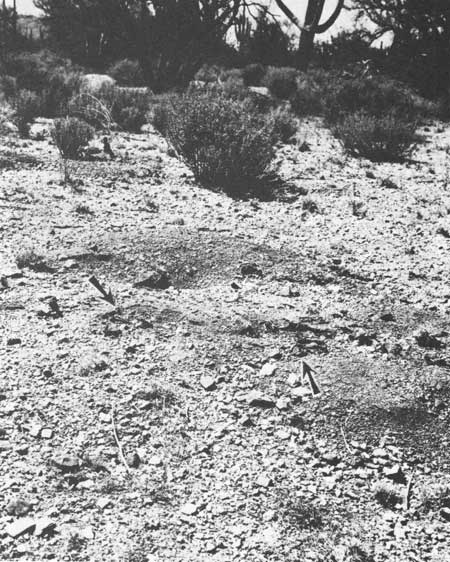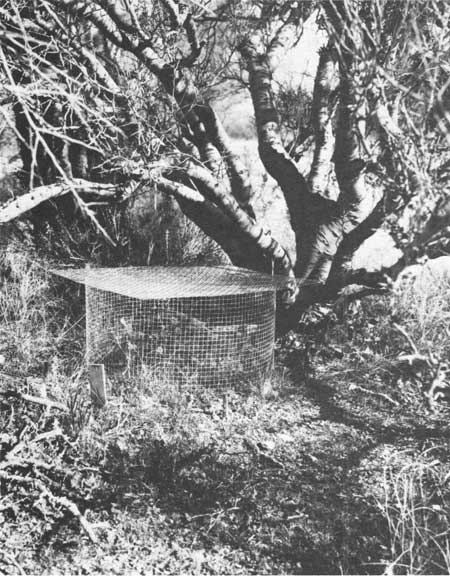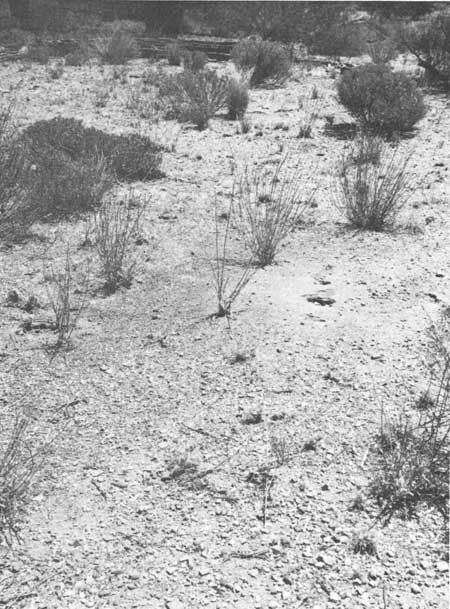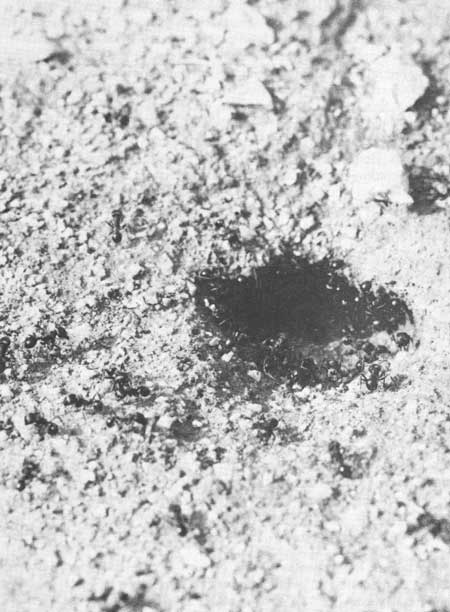|
SAGUARO
Ecology of the Saguaro: II NPS Scientific Monograph No. 8 |

|
CHAPTER 3:
THE FATE OF THE SEED: DISPERSAL, ATTRITION, AND GERMINATION (continued)
Seed Consumption and Loss
A large part of the annual saguaro seed crop is consumed by mammals, birds, and insects (Marcou 1869; MacDougal 1908a; Shreve 1951). The percentage of the annual seed crop so consumed varies greatly from one community to another depending upon the relative abundance of particular species of consumers (Fig. 18A and 18B). Field observations in Saguaro National Monument indicate that the principal seed consumers are white-winged doves (Zenaida asiatica) and western mourning doves (Zenaida macroura) (see Neff 1940) which feed on freshly opened fruits still attached to the plant, harvester ants (Pogonomyrmex sp.), and round-tailed and Harris' antelope ground squirrels (Spermophilus tereticaudus, Citellus harrisi) which feed intensively upon fruits that drop to the ground (Figs. 19 and 20).

|
| Fig. 19A. Twenty-one dried, empty receptacles of saguaro fruits (arrow) surround the entrance to the den of a round-tailed ground squirrel (Spermophilus tereticaudus) in the Cactus Forest at Saguaro National Monument (east). The succulent fresh fruits of the saguaro are an important source of moisture (as well as food) during the critically arid weeks immediately prior to the arrival of monsoon rains. Photographed 30 June 1969. |

|
| Fig. 19B. Galvanized hardware cloth exclosure was used in experiments to determine the effect of vertebrate animals on the survival of saguaro seeds and young plants at Saguaro National Monument. Net germination in plots so protected was approximately 1.3 times that in adjacent unprotected plots. The difference is attributed primarily to the effect of seed removal by birds and rodents. Photographed 21 Feb. 1969. |

|
| Fig. 20A. Harvester ant (Pogonomyrmex barbatus) nests are usually situated in exposed situations away from trees and large shrubs. Such nests are abundant in the Cactus Forest (shown) at Saguaro National Monument (east), but comparatively sparse in the west monument. Commonly foraging more than 20 m (66 ft) from the nest, harvester ants concentrate on the gathering of saguaro seeds throughout the period of fruit drop during late June and early July. Photographed 30 June 1969. |

|
| Fig. 20B. Harvester ants (Pogonomyrmex barbatus) efficiently remove large numbers of saguaro seeds that fall to the ground. In localities such as the Cactus Forest of Saguaro National Monument (east) where they are abundant, harvester ants play a primary role in limiting the number of viable seeds that survive on the ground until the occurrence of summer conditions suitable for germination. Photographed 25 June 1974. |
Ordered by the estimated relative quantity of seeds consumed, other bird-consumers are Gambel's quail (Lophortyx gambeli), curve-billed thrasher, (Toxostoma curvirostre), cactus wren (Campylorhynchus brunneicapillus), gila woodpecker (Centurus uropygialis), gilded flicker (Colaptes chrysoides), and brown towhee (Pipilo fuscus) (see Gilman 1915; Hensley 1954; Hungerford 1962). Secondary mammal-consumers include the kangaroo rat (Dipodomys sp.), pocket mouse (Perognathus sp.), white-throated woodrat (Neotoma albigula), cactus mouse (Peromyscus eremicus), long-nosed bat (Leptonycteris nivalis; Beatty 1955), coyote (Canis latrans), and collared peccary (Pecari tajacu; Eddy 1959).
The proportion of the annual seed crop harvested by birds and mammals does not provide a direct measure of potential seed survival and natural germination. Rather, the impact of such consumption must be evaluated separately for each animal species based upon the diversity of its feeding habits and the efficiency of its digestive processes. Seeds consumed by obligatory seed-eaters such as white-winged and mourning doves, kangaroo rats, pocket mice, and cactus mice are destroyed during digestion. However, a portion of saguaro seeds consumed by other species (including round-tailed ground squirrels, Harris' antelope ground squirrels, woodrats, coyotes, and omnivorous birds), which benefit primarily from the succulent tissues of the matrix, pass undamaged through their digestive tracts (Table 6 and 7; also see Shreve 1951).
| Species | Feces Dry wt (g) |
Whole seeds recovered | |||
| Wt |
No. | % Germ. | |||
| g | % of feces | ||||
| Canis latrans | — | — | — | (100) | 97.0 |
| Pecari tajacu— | — | — | (100) | 31.0 | |
| Spermophilus tereticaudus | 2.15 | 0.064 | 3.0 | 53 | 64.2 |
| Citellus harrisi | 2.10 | 0.052 | 2.5 | 43 | 53.5 |
| Neotoma albigula | 1.65 | 0.007 | 0.4 | 6 | 50.0 |
| Dipodomys merriami | 1.09 | 0 | — | 0 | — |
| Peromyscus eremicus | 0.51 | 0 | — | 0 | — |
| Perognathus baileyi | 0.40 | 0 | — | 0 | — |
| Controls (3) | — | — | — | 300 | 82.3 |
| Species | Feces Dry wt (g) |
Whole seeds recovered | |||
| Wt |
No. | % Germ. | |||
| g | % of feces | ||||
| Campylorhynchus brunneicapillus | 1.78 | 0.696 | 39.21 | 557 | 76.0a |
| Toxostoma curvirostre | 2.60 | 2.460 | 16.43 | 1297 | 54.7a |
| Zenaida asiatica (No. 1) | 2.32 | 0.004 | 0.2 | 3 | 100.0 |
| Zenaida asiatica (No. 2) | 3.41 | 0.002 | 0.1 | 2 | 100.0 |
| Controls | — | — | — | 300 | 73.7a |
aMean of three lots of 100 seeds each. | |||||
Coyote scats collected in July consisted of approximately 95% undigested saguaro seeds. Viability is essentially unaffected by passage through the coyote digestive tract (Table 6). Eddy (1959) reported collared peccary scats containing 85% undigested saguaro seeds. These mammal species together with the curve-billed thrasher, cactus wren, gila woodpecker, and gilded flicker are potentially important disseminators of saguaro seeds.
Generally, the number and proportion of whole viable seeds present in mammal droppings increase with the size of the species and/or the diversity of its feeding habits. As with mammals, birds that are primarily seed-consumers are relatively low dispersers (viable seeds are not found in feces in large numbers).
In some localities, insects play a primary role in limiting the number of viable seeds that remain on the ground until conditions suitable for germination occur. Harvester ants (Pogonomyrmex barbatus, Fig. 20) efficiently remove large numbers of seeds. Other observed seed gathering taxa include Lasius sp. and Leptothorax sp. (Steenbergh and Lowe 1969).
The results of experiments utilizing exclosures (Fig. 19B) to measure the effect of predation on germination success are given in Table 8. Low germination success (0-3.2%) in plots at three sites (see Table 8; SERS, SWRS, SWF) was associated with and is attributed to seed removal by harvester ants. Conversely, harvester ant activity was not observed in plots where comparatively high numbers of germinations were recorded. Low values for two of the east monument north-facing slope (Table 8: SERN site) plots are attributed to the localized occurrence of relatively unfavorable soil characteristics associated with deep gravel.
| Study site |
Ants obs. |
No. of seeds germinated (7/31-8/3) |
Open plots |
|||||
| Exclosure plots |
% Germ. | |||||||
| Screen A | Screen B | Screen C | Mesh | Excl. | Open | |||
| SERS | + | 101 | 266 | 0 | 1 | 28 | 9.4 | 2.8 |
| SWRS | + | 0 | 0 | 0 | 66 | 112 | 11.6 | 11.2 |
| SERN | 30 | 239 | 31 | 35 | 13 | 8.4 | 1.3 | |
| SWRN | 244 | 480 | 335 | 354 | 374 | 35.3 | 37.4 | |
| SEF | 166 | 284 | 114 | 117 | 42 | 17.0 | 4.2 | |
| SWF | + | 28 | 32 | 17 | 7 | 16 | 2.1 | 1.6 |
| Total | 2003 | 980 | 585 | |||||
| Mean | 111.3 | 163.3 | 97.5 | 12.4 | 9.8 | |||
The difference in germination percentages in open and in exclosure plots is a measure of the effect of seed removal by vertebrate consumers (Table 8). Net germination within exclosure plots was 1.27 times that in open plots. The difference is attributed primarily to the elimination of seed predation by birds and rodents.
No harvester ant activity was observed on north-facing slopes. In other areas where harvester ants were present (south-facing slopes and flat habitats), their impact was highly localized. In some of these plots all visible seeds were removed within a few days after seeding, while seeds in plots a few meters distant were essentially undisturbed. It appears that high densities of harvester ant colonies are commonly associated with stands of reproductive (adult) saguaros.
Germination success in exclosures did not provide an effective means of comparing the separate effects of seed removal by birds, mammals, and insects. Rather, the results suggest that in competition with harvester ants, the impact of larger, less efficient seed-gatherers on seed survival is relatively unimportant; the principal effect is exerted by the most efficient forager.
Thus the high attrition of seeds between seedfall and germination is due to seed removal by animals. In the Tucson area, approximately 4 in 1000 saguaro seeds that reach a site where natural germination can occur survive to become seedlings (Table 9). During the 1- to 5-week pre-germination period, native animal predators (birds, mammals, and insects) are the principal agents of saguaro seed attrition.
| Year | Sites (no.) |
Plots (no.) |
Seeds (1000) |
Germinations | |
| No. | % | ||||
| 1965 | 4 | 28 | 28 | 96 | 0.34 |
| 1966 | 4 | 13 | 36 | 87 | 0.24 |
| 1967 | 9 | 19 | 95 | 461 | 0.48 |
| Subtotal | — | 60 | 159 | 644 | 0.40 |
| 1968 | 8 | 40 | 40 | 7595 | 18.99 |
Generally, seeds remaining on the ground at summer's end are destroyed by other agents prior to the ripening of the next crop. Seemingly whole seeds from the previous year's crop collected in June from the soil surface proved to be nonviable. Seed coats showed signs of entry by small insects, or the embryos were withered and brown. Seeds which remain over winter on the ground make no important contribution to the following summer's germinable seed supply.
At Saguaro National Monument, the consumption of seeds by birds, mammals, and insects is higher at the east monument (Rincon Mountains) than at the west monument (Tucson Mountains). An approximate measure of the relative seed attrition at these two locations is offered by July observations on seeds remaining on the ground beneath vigorous adult saguaros in equivalent stages of fruit maturation. In flat habitat at the west monument, 179.5 g (6.3 oz) of seeds (approximately 131,000 seeds) were recovered from fruits collected beneath a 9-m (29.5 ft) plant with three productive arms (Fig. 18A). In similar habitat at the east monument, no seeds were present in 45 receptacles surrounding an 11-m (36.1 ft) plant with five productive arms (Fig. 18B).
The difference in yearly seed loss between the east and west monument areas is attributed primarily to consumption by animals, the round-tailed ground squirrels—abundant at the east site and absent at the west site—and harvester ants present in much greater abundance at the east site.
| <<< Previous | <<< Contents >>> | Next >>> |
chap3a.htm
Last Updated: 21-Oct-2005